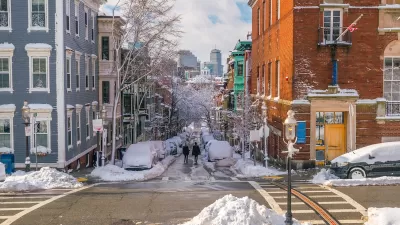Racial segregation in housing is growing and shifting as affluent enclaves form new incorporated cities and options for affordable housing in cities become more limited.

The geography of racial segregation is changing in U.S. cities, according to research by Luisa Godinez-Puig and Sharon Cornelissen for the Joint Center for Housing Studies of Harvard University. “As gentrification and housing unaffordability price lower-income residents out of major cities, we see new racial inequalities emerging on the metropolitan fringe,” they write. Two articles expand on their findings in Atlanta and Boston.
In Atlanta, the creation of new cities, which often occurs in affluent white communities, “can have large impacts on the unincorporated areas they leave behind, which are often communities of color. Indeed, by detaching themselves from county governance, new cities take resources away from the common pool of unincorporated areas and can significantly hurt the economic development of these communities.” Godinez-Puig notes that some predominantly Black communities have also incorporated, in part as a response to other new cities, but that the effects of their incorporation is unclear.
In Boston, the rapidly rising costs of housing are pushing Black families farther out of the city center as “unequal housing choices shape new locations of segregation across metropolitan Boston.” In 2020, the city was ranked 11th most segregated of the top 50 U.S. metros, resulting in disparities in economic and educational opportunities and access to healthcare and jobs. The article asserts that state governments can redress these disparities through preemption laws that promote affordable housing and eliminate exclusionary zoning and a stronger commitment to Affirmatively Furthering Fair Housing and enforcement of the Fair Housing Act.
FULL STORY: The Incorporation of New Cities Has Increased Racial Segregation in Metro Atlanta

Study: Maui’s Plan to Convert Vacation Rentals to Long-Term Housing Could Cause Nearly $1 Billion Economic Loss
The plan would reduce visitor accommodation by 25,% resulting in 1,900 jobs lost.

North Texas Transit Leaders Tout Benefits of TOD for Growing Region
At a summit focused on transit-oriented development, policymakers discussed how North Texas’ expanded light rail system can serve as a tool for economic growth.

Why Should We Subsidize Public Transportation?
Many public transit agencies face financial stress due to rising costs, declining fare revenue, and declining subsidies. Transit advocates must provide a strong business case for increasing public transit funding.

How to Make US Trains Faster
Changes to boarding platforms and a switch to electric trains could improve U.S. passenger rail service without the added cost of high-speed rail.

Columbia’s Revitalized ‘Loop’ Is a Hub for Local Entrepreneurs
A focus on small businesses is helping a commercial corridor in Columbia, Missouri thrive.

Invasive Insect Threatens Minnesota’s Ash Forests
The Emerald Ash Borer is a rapidly spreading invasive pest threatening Minnesota’s ash trees, and homeowners are encouraged to plant diverse replacement species, avoid moving ash firewood, and monitor for signs of infestation.
Urban Design for Planners 1: Software Tools
This six-course series explores essential urban design concepts using open source software and equips planners with the tools they need to participate fully in the urban design process.
Planning for Universal Design
Learn the tools for implementing Universal Design in planning regulations.
Ascent Environmental
Borough of Carlisle
Institute for Housing and Urban Development Studies (IHS)
City of Grandview
Harvard GSD Executive Education
Toledo-Lucas County Plan Commissions
Salt Lake City
NYU Wagner Graduate School of Public Service





























